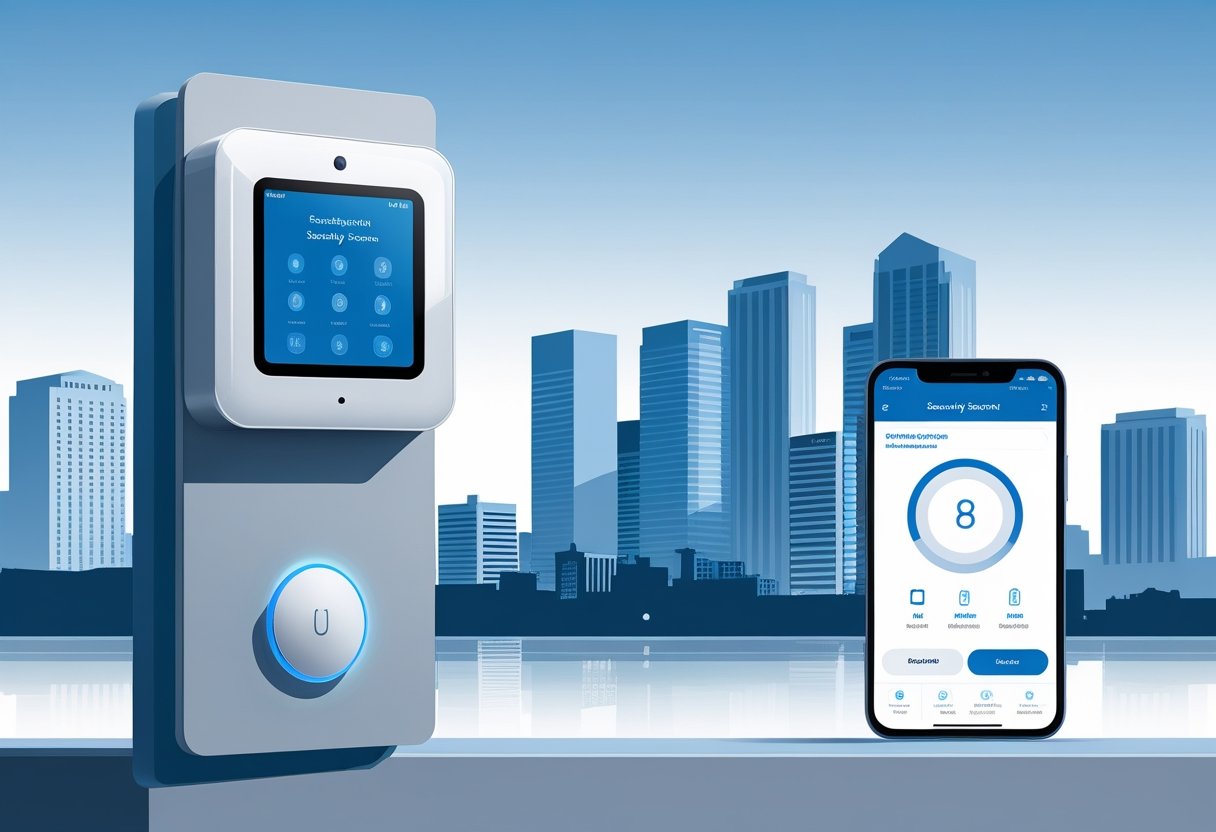Choosing the right fire alarm system for your business is crucial for ensuring safety and compliance. There are several types of commercial fire alarm systems available, each suited for different needs and building layouts. Understanding these options will empower you to make informed decisions that protect both your employees and your property.
In the greater Houston area, you want a fire alarm system that not only meets local regulations but also caters to the specific risks associated with your industry. From conventional systems that simplify detection processes to addressable systems that provide detailed information about alarm locations, each type offers unique advantages tailored to your operational requirements.
Exploring the features and benefits of various systems will enhance your approach to fire safety. By identifying the best alarm system for your business, you can ensure a swift response in case of an emergency, safeguarding lives and minimizing property damage.
What Is a Commercial Fire Alarm System?
A commercial fire alarm system is a critical safety mechanism designed to detect fires and alert building occupants. Understanding its components and functionality is essential for effective fire safety management in your business.
Key Components of Commercial Fire Alarm Systems
A commercial fire alarm system consists of several key components that work together to ensure safety. These include:
- Control Panel: The central hub that processes signals from various sensors and detectors.
- Smoke Detectors: Devices that sense smoke particles and trigger the alarm.
- Heat Sensors: Sensors that respond to temperature changes, detecting fires through heat.
- Alarm Triggers: These can be manual pull stations or automated alerts that notify occupants and emergency services.
- Notification Devices: Sirens, strobe lights, or communicators that inform people within the building of an emergency.
Each component plays a vital role in ensuring rapid detection and response to fire threats, especially for facilities located in the Greater Houston area.
How Commercial Fire Alarm Systems Work
Commercial fire alarm systems operate in a systematic manner to manage fire emergencies effectively. The process generally includes:
- Detection: Smoke and heat detectors continuously monitor the environment. For instance, if a smoke detector identifies smoke particles, it sends a signal to the control panel.
- Notification: Upon receiving a detection signal, the control panel activates alarms and notification devices. This alerts occupants to evacuate and alerts fire services to respond.
- Communication: Advanced systems can communicate directly with fire departments and provide vital information, like location and type of threat.
Understanding how these systems function can be critical in ensuring compliance and safety in your commercial space within the Houston area.
Main Types of Commercial Fire Alarm Systems
Understanding the main types of commercial fire alarm systems can aid in selecting the most effective solution for your business. These systems vary in complexity, features, and suitability based on building requirements and local regulations.
Conventional Fire Alarm Systems
Conventional fire alarm systems are ideal for smaller commercial spaces. They operate using a basic configuration that connects multiple detectors to a central control panel through distinct zones.
When a detector activates, the entire zone triggers the alarm. This system is cost-effective and straightforward but may not pinpoint the exact location of the fire.
Key features include:
- Ease of installation: Simple wiring and fewer components.
- Cost-effective: Lower initial investment compared to advanced systems.
However, due to limited connectivity and response accuracy, they work best in smaller facilities, such as retail stores or small offices.
Addressable Fire Alarm Systems
Addressable fire alarm systems offer advanced monitoring and control. Each device is assigned a unique address, allowing the control panel to identify and communicate with individual detectors.
This system enhances response efficiency by pinpointing the exact location of the alert. It's particularly useful in larger buildings or complex setups where quick and precise responses are critical.
Key aspects include:
- Detailed information: Provides real-time alerts about specific device malfunctions.
- Flexibility: Easily accommodates additional devices due to its loop configuration.
While the initial costs may be higher, the long-term benefits often justify the investment, particularly for larger businesses.
Wireless Fire Alarm Systems
Wireless fire alarm systems operate without the need for physical wiring, utilizing RF signals to connect devices to a central control panel. This feature allows for easy installation and relocation of components.
These systems are ideal for retrofitting existing buildings where wiring can be disruptive or costly. Wireless systems also reduce installation time, allowing businesses to quickly implement fire safety measures.
Benefits include:
- Reduced installation costs: No wiring needed simplifies setup.
- Adaptability: Easily reconfigured if your space changes.
These systems may require more frequent maintenance and battery checks to ensure reliability.
Hybrid Fire Alarm Systems
Hybrid fire alarm systems combine features of both conventional and addressable systems. They can use both wired and wireless devices, making them flexible enough to meet various building codes and user needs.
This type of system is advantageous in larger or older buildings needing a mix of technologies.
Features encompass:
- Versatility: Adaptable to unique building layouts.
- Comprehensive coverage: Ensures complete detection across diverse environments.
Hybrid systems may be the most effective choice when dealing with different building types, offering the best of both technologies for enhanced safety.
Specialized Fire Alarm Solutions for Commercial Buildings
In commercial settings, specialized fire alarm solutions enhance safety and ensure compliance with regulations. These systems go beyond conventional alarms, incorporating advanced technology to improve response times and communication during emergencies.
Voice Evacuation Systems
Voice evacuation systems play a crucial role in guiding occupants during a fire emergency. Unlike standard alarms that produce only sounds, these systems deliver clear spoken instructions alongside audible alerts.
This capability helps reduce confusion and facilitates a smooth evacuation process. With built-in microphones, these systems can adapt messages based on real-time conditions, allowing for tailored instructions depending on the situation. Additionally, voice evacuation systems can integrate with existing fire alarms to provide a cohesive response strategy.
In the greater Houston area, implementing this advanced technology ensures compliance with local safety standards while enhancing the protection of your building and its occupants.
Integrated Mass Notification Systems
Integrated mass notification systems expand the functionality of fire alarms by combining emergency communication modalities. These systems send alerts through various channels, including text messages, email notifications, and visual signals.
In commercial buildings, this integration is vital for informing and directing not just about fire alerts but also other emergencies such as severe weather or security threats.
You can customize notifications for different areas within your facility, ensuring that relevant information reaches the right audience promptly. By using these systems, you enhance your building's overall safety infrastructure and keep occupants informed in critical situations.
Multi-Sensor Detection Technology
Multi-sensor detection technology enhances fire alarm performance by combining multiple types of sensors in a single device. This approach improves the accuracy of fire detection and reduces false alarms.
These systems typically integrate smoke, heat, and carbon monoxide sensors. By analyzing data from each sensor, they can identify potential hazards more effectively than single-sensor systems.
In complex commercial environments, this technology adapts to changing conditions, ensuring optimal performance. It provides quicker responses, contributing to maintaining a safer environment for your employees and visitors.
Choosing systems equipped with multi-sensor technology is a proactive measure in advancing your fire safety strategy within your building.
Critical Fire Detection Devices in Commercial Systems
In a commercial fire alarm system, specific devices play crucial roles in detecting potential threats. Each type of device has distinct functions and benefits that ensure the safety of occupants and property.
Manual Pull Stations
Manual pull stations are essential for initiating a fire alarm when a fire is observed. Typically located near exits or in high-traffic areas, these devices allow you to alert others immediately by pulling a lever or button.
These stations are easy to use and require no special training, making them accessible to anyone. They should be clearly marked and regularly inspected to ensure they are functional. In the event of an emergency, your quick action can help minimize damage and save lives.
Smoke and Heat Detectors
Smoke and heat detectors are critical components of commercial fire alarm systems. Smoke detectors identify particles in the air caused by fire, while heat detectors respond to rapid temperature increases.
Both types work in tandem to provide early warnings. You can set up smoke detectors throughout your facility, particularly in hallways and large rooms. Heat detectors are often installed in environments where smoke detectors may trigger false alarms, such as kitchens or workshops.
Regular testing and maintenance are necessary to ensure they function correctly. Integrating these detectors with a centralized control panel enhances the system's reliability and responsiveness.
Carbon Monoxide Detectors
Carbon monoxide detectors are vital for any commercial setting, especially where gas appliances are used. Carbon monoxide is an odorless, colorless gas that poses serious health risks, making these detectors essential for occupant safety.
These devices work by measuring levels of carbon monoxide in the air and triggering an alarm when they reach dangerous thresholds. You should install them in areas such as break rooms and maintenance areas where gas appliances may be present.
Frequent testing and calibration of these detectors guarantee their accuracy. Linking carbon monoxide detectors to your control panel allows for comprehensive monitoring and faster response in case of gas leaks.
Fire Safety Standards and Compliance Considerations
Understanding fire safety standards and compliance is essential for ensuring the effectiveness of your commercial fire alarm system. Adhering to regulations not only promotes safety but also protects your business from legal liabilities.
Fire Safety Regulations for Commercial Properties
In the United States, commercial properties must comply with specific fire safety regulations, primarily outlined by the National Fire Protection Association (NFPA). NFPA 72 is critical, detailing the design, installation, and maintenance standards for fire alarm systems.
Compliance with local building codes is equally important. These codes vary by municipality and may prescribe additional requirements based on the type of building, occupancy type, and size. For example, high-rise buildings often have stricter guidelines to ensure occupant safety.
Moreover, your fire alarm system should be able to interconnect with other safety systems like sprinklers and emergency lighting. Regular inspections and updates are vital to maintain compliance and optimal functioning of the systems.
Industry Compliance and System Testing
Regular testing of your fire alarm system is necessary to meet compliance standards. This includes functional testing according to NFPA guidelines, which state that fire alarms should be tested at least annually.
You should document all inspections and tests, as this information may be required during safety audits. Engaging a professional service for installation and maintenance can ensure adherence to these compliance requirements.
In the greater Houston area, certified companies can assist you in maintaining compliance, performing all necessary tests and inspections to keep your systems up to code. Following these guidelines not only strengthens safety protocols but also enhances your operational efficiency.
Frequently Asked Questions
Understanding the nuances of commercial fire alarm systems can help you make better decisions for your business. Below are some frequently asked questions that address the key components, types, and features of these essential safety systems.
What are the different categories of commercial fire alarm systems?
Commercial fire alarm systems fall into several categories, including conventional, addressable, and smart fire alarm systems. Each type is designed to meet specific building sizes and complexities, ensuring that safety measures are appropriately tailored to your environment.
How do conventional fire alarm systems differ from other types?
Conventional fire alarm systems operate by dividing a building into zones, where alarms are triggered in a specified area. In contrast, addressable systems use unique identifiers for each device, allowing for more precise location tracking of alarms, which can speed up emergency response.
Can you list the common types of fire detectors used in commercial settings?
Common types of fire detectors include smoke detectors, heat detectors, and flame detectors. Each type serves a unique function: smoke detectors respond to smoke particles, heat detectors activate based on temperature changes, and flame detectors identify specific wavelengths of light emitted from flames.
What components make up a standard fire alarm panel?
A standard fire alarm panel consists of a control unit, notification devices, and various input devices. The control unit is the brain of the system, while notification devices, such as alarms and strobe lights, alert occupants. Input devices include manual pull stations and various types of detectors.
How many types of fire alarm systems are typically used in commercial properties?
Typically, there are five main types of fire alarm systems used in commercial properties: conventional, addressable, hybrid, wireless, and smart systems. Each type is suited for different operational needs and regulatory requirements, allowing you to choose the best fit for your specific setting.
What key features differentiate the various fire alarm systems for commercial use?
Key features that differentiate fire alarm systems include the method of detection, installation requirements, and integration capabilities. Some systems may offer advanced features like remote monitoring and maintenance alerts, which can enhance safety and compliance within your commercial space.
.svg)



.svg)


.svg)



